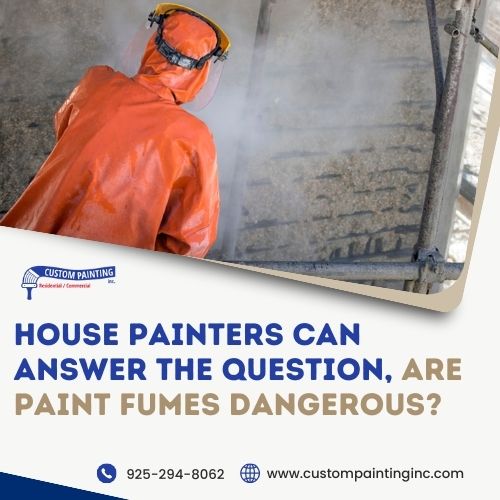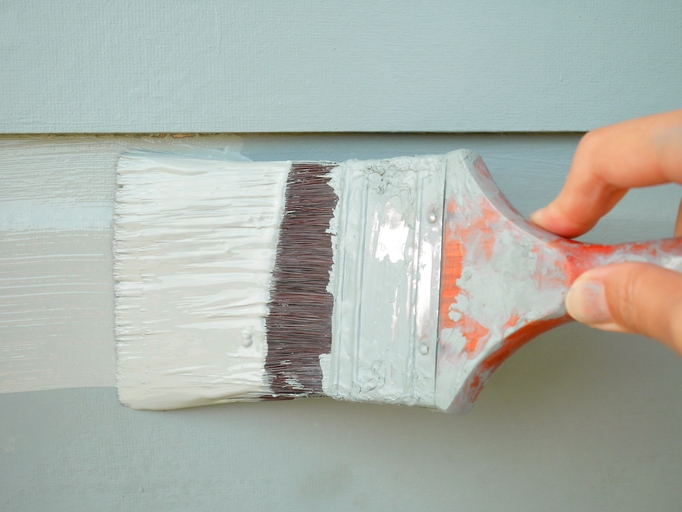When it comes to home improvement for San Ramon area homeowners and businesses, painting is often at the top of the list. Whether tackling the project yourself or hiring professional house painters, it’s essential to understand the potential risks associated with paint fumes.
While that fresh coat of paint or new epoxy flooring can transform a space, its fumes can pose health hazards if not handled properly. This article will explore the dangers of paint fumes, how to protect yourself, and why hiring professionals like Custom Painting, Inc. might be the best decision for a safe and beautiful finish.
What are VOCs?
When planning a painting project, it’s easy to get caught up in choosing colors and finishes, but it’s equally important to understand what’s actually in the paint. Most paints, whether used indoors or outdoors, contain volatile organic compounds, or VOCs. These chemicals help the paint flow smoothly and adhere to surfaces, but they also evaporate into the air as the paint dries, creating fumes.
There are two main types of paint: latex (water-based) and oil-based. Latex paints are popular because they dry quickly, are easy to clean, and generally have fewer fumes than oil-based paints. However, even latex paints aren’t entirely free of VOCs. That’s why it’s essential to take steps to protect yourself and your family from any potential harm.
You might immediately notice the smell of paint—some people even enjoy that “freshly painted” scent—but it’s more than just an odor. These fumes can cause irritation to your eyes, nose, and throat, and if you’re exposed to them for too long, they can lead to more severe health issues. This is especially true for certain groups of people, like young children, the elderly, and anyone with existing health conditions.
The Science Behind Paint Fumes
When you open a can of paint, you’re releasing a mix of chemicals into the air, many of which are known as volatile organic compounds (VOCs). VOCs are the key ingredients that help paint flow smoothly and dry properly, but they also evaporate into the air, creating those strong fumes you notice during and after painting.
VOCs are organic chemicals containing carbon and can include benzene, formaldehyde, and toluene. These chemicals are released into the air as the paint dries, where they can react with other elements to create potentially harmful byproducts. This is why you might experience eye or throat irritation, headaches, or even dizziness when exposed to paint fumes for too long. In more severe cases, long-term exposure to certain VOCs has been linked to more serious health problems, such as liver and kidney damage or even cancer.
Beyond health risks, VOCs contribute to environmental issues like smog formation. When VOCs are released into the atmosphere, they can react with nitrogen oxides in the presence of sunlight to form ground-level ozone, a major component of smog. This not only affects air quality but also contributes to global warming.
Innovations in Paint Technology
Thankfully, the paint industry has made significant strides in reducing the harmful effects of VOCs. Modern advancements have led to developing low-VOC and VOC-free paints that still provide excellent coverage and durability but with fewer health risks. These paints are designed to release fewer chemicals into the air, making them a safer option for indoor use, especially in homes with children, elderly residents, or individuals with respiratory conditions.
Newer technologies also include water-based paints that dry faster and have significantly lower VOC content. Some innovative products even use natural ingredients, like plant-based resins, which further reduce the paint’s chemical footprint. The trend is moving toward greener, more sustainable options, which is great news for our health and the environment.
Common Myths About Paint Fumes and Safety
When it comes to paint fumes and safety, there are a lot of misconceptions floating around. Let’s clear up some of the most common myths and help you make informed decisions for your next painting project.
Myth 1: All water-based paints are completely safe.
Many people believe that because water-based or latex paints are less toxic than oil-based ones, they’re completely safe. While it’s true that water-based paints generally have lower levels of VOCs, they’re not entirely free of these chemicals. Even low-VOC water-based paints can release some fumes into the air. If you’re painting in a poorly ventilated area, these fumes can still cause irritation and health issues, particularly for sensitive individuals like children, the elderly, or those with respiratory conditions.
Myth 2: Low-VOC means zero risk.
Another common misconception is that if a paint is labeled as low-VOC, it poses no health risks. While low-VOC paints are indeed safer because they emit fewer harmful chemicals, they don’t eliminate risk entirely. Trace amounts of VOCs are still present, and prolonged or repeated exposure can still cause health issues. It’s essential to take the same precautions with low-VOC paints as you would with any other type, such as ensuring proper ventilation and using protective equipment.
Myth 3: Ventilation isn’t necessary with low-VOC or VOC-free paints.
Some believe that they don’t need to worry about ventilation because they’re using low-VOC or VOC-free paints. However, even VOC-free paints can release other chemicals into the air, especially during application and drying. Good ventilation is crucial to disperse any fumes and ensure a safe environment. It’s recommended to keep windows open and use fans to help circulate fresh air for at least 24 hours after painting.
Myth 4: Paint fumes only cause short-term discomfort.
Many assume that the effects of paint fumes are limited to temporary issues like headaches or eye irritation. While these are the most common immediate symptoms, long-term exposure to VOCs can lead to more serious health problems, including liver and kidney damage, respiratory issues, and even an increased risk of cancer. This is why taking preventive measures is so important, even for short-term projects.
Myth 5: Protective gear isn’t necessary for small painting jobs.
Some people think that protective gear is only needed for large-scale painting projects or when using particularly strong paints. In reality, even small jobs can expose you to harmful fumes, especially if done in confined spaces. Wearing gloves, goggles, and a dust mask or respirator helps protect you from skin contact and inhalation of fumes, reducing the risk of both immediate and long-term health effects.
Preventative Measures
When it comes to painting, taking the right precautions can significantly reduce your exposure to harmful fumes. The good news is that with a few simple steps, you can keep yourself and your family safe while still achieving that beautiful, freshly painted look.
1. Ventilation is Key
Ensuring proper ventilation is one of the easiest ways to minimize your exposure to paint fumes. If you’re painting indoors, open up as many windows and doors as possible to let fresh air circulate. Turning on fans can also help push the fumes out of the room. It’s a good idea to keep the area well-ventilated for at least 24 hours after you finish painting and keep the windows open for a minimum of 2 hours after finishing painting. This helps to clear any lingering fumes before anyone spends significant time in the room.
2. Use Personal Protective Equipment (PPE)
Even with good ventilation, protecting yourself with PPE is still smart. This includes wearing gloves to prevent skin contact with paint, goggles to protect your eyes, and a dust mask or respirator to filter out harmful fumes. These simple tools can make a big difference in reducing your risk of exposure.
3. Consider Low-VOC or VOC-Free Paints
Another way to reduce your risk is to choose paints labeled as low-VOC or VOC-free. These products are designed to release fewer harmful chemicals into the air. While they might still contain small amounts of VOCs, they are generally much safer than traditional paints. Just keep in mind that “VOC-free” doesn’t always mean completely free of these compounds, so ventilation is still important.
4. Paint Outdoors When Possible
If your project allows for it, painting outdoors is always the safest option. The open-air helps disperse fumes quickly, reducing your exposure to potentially harmful chemicals. If you must paint indoors, try to limit the amount of time you spend in the freshly painted area until the fumes have had time to dissipate.
Why Hire Professionals?
Painting your home might seem straightforward, but when dealing with paint fumes and ensuring a top-quality finish, hiring professional painters is often the best choice. Here’s why:
1. Expertise in Safety
Professional painters are trained to handle paint and fumes safely. They know how to properly ventilate a space and use the best protective equipment to minimize exposure to harmful chemicals. Their experience means they can complete the job efficiently without compromising safety.
2. High-Quality Results
While DIY painting can be rewarding, it often requires significant time and effort, and the results might not always meet your expectations. Professional painters bring experience, precision, and skill to the table, applying the paint evenly and beautifully. They have the tools and knowledge to tackle any challenges, whether it’s painting high ceilings, dealing with tricky corners, or achieving a flawless finish.
3. Peace of Mind
Perhaps the most compelling reason to hire professionals is the peace of mind it brings. When you hire experts like Custom Painting, Inc., you can trust that the job will be done right the first time. You won’t have to worry about the risks of paint fumes or the stress of managing a big project. Instead, you can focus on enjoying your newly painted space.
4. Time and Convenience
Painting a room or an entire house is time-consuming, especially if you have other responsibilities. Professionals can complete the job quickly and efficiently, freeing up your time for other things. Plus, they handle all the prep work, painting, and cleanup, so you don’t have to lift a finger.
Conclusion
After exploring the potential dangers of paint fumes and the measures you can take to protect yourself, it’s clear that safety should be a top priority during any painting project.
While you can take steps on your own, such as using low-VOC paints and ensuring proper ventilation, sometimes the best option is to leave the job to the professionals. Hiring experts like Custom Painting, Inc. guarantees a beautiful, professional finish and gives you peace of mind, knowing that the work is being done safely and efficiently.
So, if you’re ready to refresh your home’s look without the worry of dealing with paint fumes, consider reaching out to Custom Painting, Inc. Let the professionals take care of everything, from preparation to cleanup, so you can sit back, relax, and enjoy your beautifully painted space. Call us at 925-866-9610 or fill out our contact form to schedule an appointment to get a free estimate!


